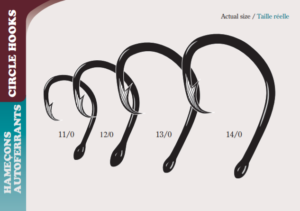Circle Hooks
WHAT ARE CIRCLE HOOKS?
Circle hooks are modified fishing hooks, used in pelagic longline and pole & line fisheries, in which the pointed end of the hook sits at a right angle to its shank, creating a smaller opening between the two than that of typically-used J hooks. The reduced opening minimises the risk of bycatch for marine mammals, sharks, rays, and turtles. In some fisheries, use of circle hooks is combined with alternative bait (for example, using squid instead of fish). Circle hooks can be combined with the use of an alternative bait, baiting the hooks with squid in place of fish to deter non-target elasmobranch species.

Source: Beverly 2009
CURRENT RESEARCH & USE
Circle hooks have been trialled in longline pelagic and demersal fisheries in the Atlantic, Pacific, and Indian Oceans. Trials suggest that their use can help reduce bycatch of certain cetaceans, turtles and seabirds, while the picture is much more mixed when it comes to sharks. Their use is mandatory in Hawaiian shallow-set longline fisheries, and they have been adopted voluntarily elsewhere.
Elasmobranchs
Some studies have found that circle hooks increase the catch rates of sharks and rays while tending to reduce overall mortality due to the shallower nature of injuries. A study on the effect of circle hook use, compared with more traditional J-hooks, on the incidental capture of North Atlantic shortfin mako sharks in longline fisheries found that on-deck mortality fell by 10%. Total mortality was also expected to be lower, due to circle hooks being more likely to result in mouth hooking rather than gut hooking or foul hooking. Similarly, a study of a longline fishery in the South Adriatic Sea found that while circle hooks had no significant effect on catch rates of target species nor bycatch rates of non-target species, blue sharks were much less likely to be significantly injured during bycatch events by using circle hooks than by J-hooks. However, circle hooks have been found to increase catches of deep-water sharks in the Azores bottom longline fishery without significantly reducing the risk of severe injury, indicating the unsuitability of this mitigation method for some species.
Turtles
The increased width of circle hooks is of benefit to turtles, reducing the likelihood of deep hooking (whereby the hook lodges in the oesophagus, respiratory organs, or roof of the mouth), resulting in less injury. A study of a tuna pole-and-line fishery in Vietnam found that circle hooks resulted in significantly lower turtle bycatch. A multi-year study in the Azorean longline fishing fleet also yielded significant reductions in both bycatch and injury of loggerhead sea turtles.
Cetaceans
Odontocetes (dolphins, porpoises and all other whales possessing teeth) are believed to be at less risk of bycatch from circle hooks than J-shaped hooks.
Interested in how this and other measures could mitigate bycatch in your fishery? Get in touch with us to collaborate or take part in a study.
This page was last updated on 22.05.24.

